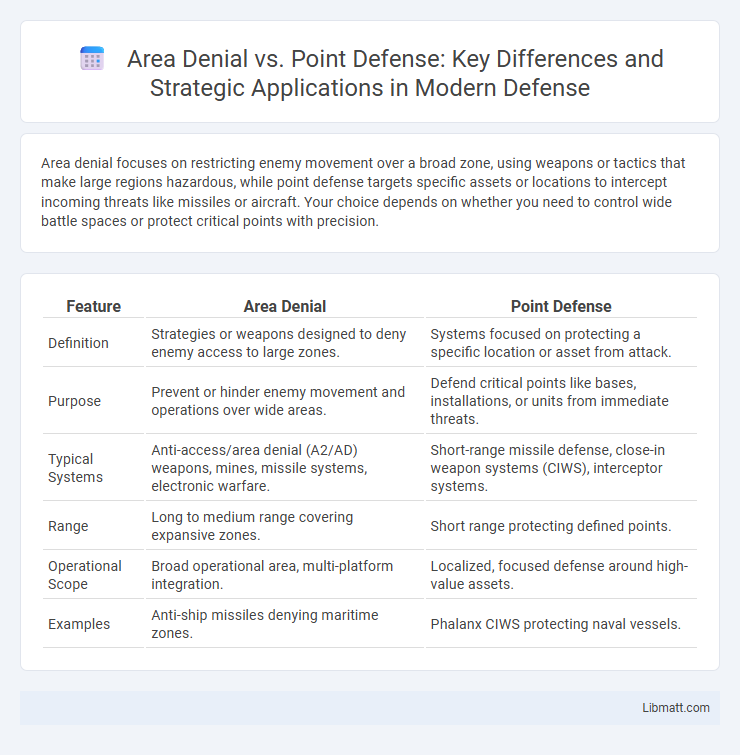Area denial focuses on restricting enemy movement over a broad zone, using weapons or tactics that make large regions hazardous, while point defense targets specific assets or locations to intercept incoming threats like missiles or aircraft. Your choice depends on whether you need to control wide battle spaces or protect critical points with precision.
Table of Comparison
| Feature | Area Denial | Point Defense |
|---|---|---|
| Definition | Strategies or weapons designed to deny enemy access to large zones. | Systems focused on protecting a specific location or asset from attack. |
| Purpose | Prevent or hinder enemy movement and operations over wide areas. | Defend critical points like bases, installations, or units from immediate threats. |
| Typical Systems | Anti-access/area denial (A2/AD) weapons, mines, missile systems, electronic warfare. | Short-range missile defense, close-in weapon systems (CIWS), interceptor systems. |
| Range | Long to medium range covering expansive zones. | Short range protecting defined points. |
| Operational Scope | Broad operational area, multi-platform integration. | Localized, focused defense around high-value assets. |
| Examples | Anti-ship missiles denying maritime zones. | Phalanx CIWS protecting naval vessels. |
Introduction to Area Denial and Point Defense
Area denial strategies aim to restrict enemy movement across broader zones using weapons like mines, artillery, or electronic jamming, while point defense focuses on protecting specific targets such as military bases or critical infrastructure with localized interceptors or shield systems. Understanding the operational scope, range, and effectiveness of each method helps optimize defensive capabilities tailored to tactical needs. Your choice between area denial and point defense depends on whether you prioritize widespread coverage or concentrated protection of key assets.
Defining Area Denial: Concepts and Purposes
Area denial refers to military strategies and technologies designed to prevent enemy forces from occupying or traversing a specific region, using weapons such as mines, artillery, or anti-aircraft systems. Unlike point defense that protects a single asset or location, area denial aims to control larger battlefield zones by creating hazardous environments or restricting movement. Your understanding of area denial highlights its critical role in shaping tactical advantages and influencing enemy behavior across extensive terrains.
Point Defense Explained: Functions and Applications
Point defense systems provide targeted protection by intercepting threats in a defined, often limited, area, making them critical for safeguarding high-value assets such as military bases, ships, and radar installations. These systems employ short-range missile interceptors, anti-aircraft guns, or close-in weapon systems (CIWS) to neutralize incoming missiles, aircraft, or drones within seconds of detection. You benefit from enhanced survivability and operational continuity by deploying point defense in environments where rapid, localized threat neutralization is essential.
Key Differences Between Area Denial and Point Defense
Area denial strategies prioritize restricting enemy movement across broad territories using weapons like landmines and missile systems, effectively creating zones that are hazardous to traverse. Point defense focuses on protecting specific critical assets, such as military bases or aircraft carriers, using targeted systems like anti-missile interceptors and close-in weapon systems. Understanding these key differences helps you deploy the right approach to balance wide-area control and precise asset protection in your defense planning.
Technologies Enabling Area Denial Systems
Area denial systems utilize advanced technologies such as radar-guided missile platforms, automated mine-laying robots, and electronic jamming devices to prevent enemy forces from accessing strategic regions. Integration of drone swarms equipped with precision targeting enhances coverage and responsiveness, making these systems highly adaptive and scalable. Your defense strategy can leverage AI-driven surveillance and sensor fusion to optimize detection and engagement accuracy in area denial scenarios.
Innovations in Point Defense Mechanisms
Innovations in point defense mechanisms include the integration of advanced radar-guided interceptors and automated close-in weapon systems (CIWS) that enhance real-time threat detection and neutralization. Developments in laser-based directed energy weapons provide precise, rapid-response capabilities against incoming projectiles, reducing reliance on traditional kinetic interceptors. These advancements significantly increase the effectiveness of point defense systems in protecting high-value assets from missile and drone attacks.
Strategic Advantages of Area Denial Approaches
Area denial strategies enhance strategic control by limiting enemy movement across broad regions, forcing adversaries into predictable channels conducive to defensive operations. These approaches leverage integrated weapon systems such as anti-vehicle mines, long-range missile batteries, and electronic jamming to create persistent, layered barriers that complicate enemy penetration. The expansive coverage of area denial methods ensures sustained pressure on hostile forces, reducing their operational flexibility while minimizing friendly force exposure compared to point defense tactics.
Point Defense in Modern Warfare Scenarios
Point defense in modern warfare scenarios involves protecting critical assets such as military bases, aircraft carriers, or important infrastructure using short-range systems like surface-to-air missiles, close-in weapon systems (CIWS), and anti-missile interceptors. These systems provide rapid response against incoming threats including missiles, drones, and aircraft within a limited radius, ensuring localized but highly effective protection. Advanced radar and sensor networks enhance detection and targeting accuracy, making point defense essential for safeguarding high-value targets in dense threat environments.
Case Studies: Successful Area Denial and Point Defense Systems
The Russian A2/AD (Anti-Access/Area Denial) strategy in the Black Sea region demonstrates successful area denial by integrating long-range missile systems, electronic warfare, and naval mines to restrict adversary movements effectively. Conversely, the U.S. Navy's Aegis Combat System exemplifies point defense by providing precise missile intercept capabilities to protect individual ships and critical assets from incoming threats. Your operational planning can benefit from these case studies by understanding how area denial systems create broad defensive perimeters while point defense ensures targeted protection.
Future Trends in Area Denial and Point Defense Strategies
Emerging trends in area denial emphasize autonomous systems and AI-driven sensors to enhance real-time threat detection and response over expansive zones. Point defense strategies increasingly integrate directed-energy weapons and hyper-accurate interceptors to protect critical assets against precision-guided munitions. The convergence of networked defense grids and multi-domain operations shapes next-generation frameworks, maximizing both area-wide coverage and localized protection efficiency.
area denial vs point defense Infographic

 libmatt.com
libmatt.com